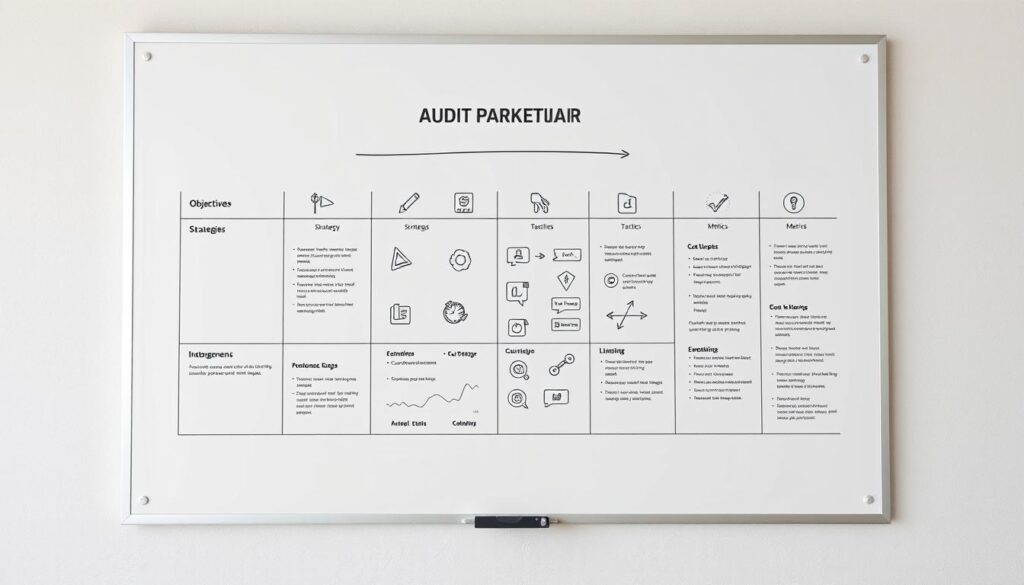What Happens When You Stop Chasing Every Marketing Trend
You’re exhausted. Every week, there’s a new platform, tool, or tactic that claims to change your business. It goes from TikTok to AI chatbots to the latest social media updates. This constant need to keep up leads to marketing overwhelm, draining your energy and scattering your focus.
Keith Wells says it best: “Chasing every change makes you lose your identity and drains your energy.” He suggests asking “What should we not change?” instead. This simple change can make a big difference.
Michelle Whitney knows this feeling well. She tried to follow every trend early in her career. This left her overwhelmed with 100 ideas at once, trying to keep up with many marketing trends. In the end, she did nothing. Does this sound like you?
James Hipkin reminds us that every generation faces its own challenges. From political gridlock to generational shifts, chaos isn’t new. What’s different is how you respond to it.
The solution isn’t trying harder to keep up with every trend. It’s about making a fundamental shift toward strategies that build sustainable growth through conversion optimization. This means focusing on strategies that work well over time, not just trying out new things that might not.
Key Takeaways
- Chasing every new platform and tactic creates exhaustion and prevents sustainable business growth
- Asking “what should we not change” helps maintain your brand identity and focus
- Trend-jumping often leads to doing nothing effectively, not achieving meaningful results
- Every generation of business owners faces unprecedented challenges and constant change
- Shifting from reactive trend-chasing to strategic focus delivers compounding returns over time
- Your finite resources achieve better results when directed toward proven strategies, not scattered across disconnected tactics
The Real Cost of Chasing Every Marketing Trend
Chasing every marketing trend can cost more than just your marketing budget. It can also harm the core of your business. New software and platform fees are easy to see. But the deeper damage is often hidden until it’s too late.
This damage affects your marketing’s effectiveness. It erodes your brand’s identity and your team’s ability to do their best work.
Why Your Marketing Feels Like a Never-Ending Race
You start with one strategy, but soon, three more tactics arrive. This constant change makes every decision feel overwhelming.
The truth is, the marketing world changes faster than any business can keep up. New channels and tools promise to be the next big thing. Social platforms and AI tools claim to revolutionize content overnight.
This creates “marketing whiplash”, as described by James Hipkin. It leads to vendor chaos and budget decisions based on last month’s sales. You chase every new tactic without seeing how they fit into your goals.
You never feel like you’re doing enough because the goalposts keep moving. You master one platform, then another becomes “essential.” This endless race causes strategic paralysis, making you hesitant to commit to anything.

The Financial Impact of Constantly Switching Platforms and Tools
Every change comes with a cost that goes beyond the obvious. Switching directions means starting over, losing the momentum you’ve built.
Here’s the financial toll of constantly switching:
- Subscription costs for tools you barely use: Most businesses keep 3-5 marketing software subscriptions they’ve outgrown but continue paying for
- Hiring specialists for short-lived initiatives: You hire experts for platforms you’ll abandon in six months, paying high rates for temporary solutions
- Lost advertising spend: Your marketing budget is scattered across multiple channels before any one can optimize and deliver ROI
- Training investments that evaporate: Time and money spent educating your team on platforms that won’t be part of your strategy next quarter
- Content creation without strategy: You produce assets that don’t fit into any larger story, wasting creative and production resources
Businesses chasing trends spend 40-60% more on marketing than those with focused strategies. Yet, they get fewer qualified leads. You’re spending more to achieve less.
This marketing FOMO leads to a vicious cycle. Increased spending demands more experimentation to justify the cost. While your competitors build expertise and efficiency, you’re stuck in a cycle of constant change.
How Trend-Hopping Erodes Your Brand Identity and Trust
Keith Wells says, “Chasing every change blurs your identity and drains energy.” When your messaging changes every quarter, your audience gets confused about who you are.
“The strongest brands are built on an idea that remains consistent while products and services come and go.”
Your customers see you everywhere, but they don’t recognize a consistent message. This inconsistency makes them skeptical, not confident.
Brand consistency isn’t about being boring. It’s about keeping a recognizable core identity while adapting your tactics. When you chase trends, you lose the trust you’ve built.
Michelle Whitney learned this lesson: “Your brand does not need to jump on every trend. Many just aren’t relevant.” Businesses that stand for something specific command premium prices and loyal followings.
Customers trust brands they’ve interacted with consistently over time. Every drastic change asks your audience to get to know you again. Most won’t bother.
The Toll on Your Team’s Energy and Morale
The human cost of trend-chasing is often overlooked. It affects your marketing team’s morale and effectiveness. They face constant changes, never mastering a channel before moving on.
This creates a demoralizing work environment. Your team feels like their efforts are futile. They invest time and energy in new platforms and strategies, only to have leadership change direction.
James Hipkin notes that this approach results in businesses “constantly putting out fires, but nothing’s really growing.” Your team becomes firefighters, responding to crises instead of executing a strategy.
Consider the practical implications:
- Team members never develop deep expertise in any single area, remaining perpetual beginners
- Burnout rates increase as people feel their work is disposable
- Top talent leaves for companies with clearer strategic direction
- Remaining team members become cynical about new initiatives, knowing they’ll likely be abandoned
The cumulative effect is a marketing operation that consumes more resources but delivers less. Your team’s capacity is stretched thin, meaning nothing gets the focus it needs for excellence.
Sustainable marketing success requires focusing on fewer channels with consistent execution. When you stop chasing trends, your team can focus, master their craft, and see meaningful results.
How to Recognize and Overcome Marketing Overwhelm
Feeling overwhelmed by marketing tasks is a common problem. The first step to solve it is to recognize the issue. It’s not about working harder or finding more time. It’s about focusing on what works and eliminating what doesn’t.
Many small business owners struggle to know when they’re doing too much. The signs can be hard to see until someone points them out.

The Warning Signs You’re Doing Too Much
Signs of doing too much marketing can be hidden. Marketing consultant Michelle Whitney once felt overwhelmed by too many ideas. She said, “100 ideas at once, trying to keep up with multiple trends, and in the end… doing nothing.”
Your calendar might be full of marketing tasks, but you might not see results. This is a clear warning sign.
Here are signs you’re doing too much marketing:
- Platform proliferation without purpose: You’re active on six different social media platforms but can’t identify meaningful marketing ROI from any single channel
- Tool overload: You pay for subscriptions to a dozen marketing tools but actively use less than 20% of their features
- Tactical obsession: Your team discusses marketing tactics constantly but rarely reviews what’s actually driving revenue
- Frantic content creation: You’re producing content at a breakneck pace without clear understanding of your target audience or desired outcomes
- Perpetual exhaustion: You feel constantly behind despite working harder than ever before
If you see yourself in these signs, you’re experiencing marketing overwhelm. The good news is that recognizing this is the first step to solving it.
Understanding Why Less Can Generate More Results
Doing less can actually lead to better results in marketing. This idea goes against what we’re often taught about success. Yet, many businesses have found that focusing on a few key areas can lead to breakthroughs.
By focusing on a few marketing channels, you can become an expert. This expertise leads to better performance and clearer results. It’s like investing in a few well-chosen stocks instead of spreading your money too thin.
Your audience will start to recognize you on specific platforms. They’ll know where to find you and what to expect. This can’t happen if you’re scattered everywhere without a clear strategy.
The Difference Between Being Busy and Being Effective
Being busy and being effective are two different things. Being busy means your schedule is full of marketing tasks. Being effective means those tasks actually help your business grow.
James Hipkin heard from a client who felt overwhelmed. The client said, “We feel like we’re constantly putting out fires, but nothing’s really growing.” This shows the difference between being busy and being effective.
Here are signs you’re doing too much marketing:
- Platform proliferation without purpose: You’re active on six different social media platforms but can’t identify meaningful marketing ROI from any single channel
- Tool overload: You pay for subscriptions to a dozen marketing tools but actively use less than 20% of their features
- Tactical obsession: Your team discusses marketing tactics constantly but rarely reviews what’s actually driving revenue
- Frantic content creation: You’re producing content at a breakneck pace without clear understanding of your target audience or desired outcomes
- Perpetual exhaustion: You feel constantly behind despite working harder than ever before
Being busy doesn’t mean you’re effective. You can spend a lot of time on marketing without seeing results. The key is to make sure every hour you spend on marketing helps your business grow.
To be effective, you need to ask tough questions. For example, which marketing activities brought in your last customers? What percentage of your marketing budget can you trace to revenue? If you cut your marketing in half, would anyone notice?
Real Examples of Businesses That Succeeded by Doing Less
Many companies have proven that focusing on a few key areas can lead to better results. This includes big companies and small businesses dealing with marketing overwhelm. These examples show that doing less can lead to more success.
During the 2008 recession, Procter & Gamble kept their advertising budget the same. They focused on their established marketing channels. This strategy helped them come out of the recession stronger, with more market share and customer loyalty.
Research from Harvard Business Review found that companies that kept or increased their marketing during the recession grew faster. This shows that being consistent is more important than cutting costs.
One of James Hipkin’s clients was overwhelmed by too many marketing channels. They were chasing every new platform without seeing results. After focusing on just two channels that matched their best customers’ habits, they saw a big improvement.
These stories aren’t just lucky breaks. They show a fundamental principle: focusing on a few key areas is more effective than spreading yourself too thin. Michelle Whitney learned this lesson herself, saying, “patience and selectivity are far more powerful than speed.”
Successful businesses know their customers well and focus on the marketing channels that reach them. They aim for excellence in those channels, not mediocrity across many. This approach reduces overwhelm and improves results by building expertise and consistency.
Your Step-by-Step Plan to Stop Trend-Chasing and Refocus
To break free from trend-chasing, you need a solid plan. This plan will change how you make marketing decisions. It will help you regain control and protect your strategy from constant changes.
This isn’t about giving up on innovation or missing out on opportunities. It’s about creating filters to separate real strategic moves from distractions.
Step 1: Conduct a Complete Marketing Audit
First, understand what you’re doing now. Many business owners can’t list all their marketing activities without looking at receipts and logins. This lack of clarity makes it hard to focus your energy.
An honest marketing audit shows the gap between where you think you’re investing and where you actually are. You’ll find marketing metrics that surprise you when you see them all together.
List Every Active Marketing Channel and Campaign
Start by making a list of every marketing channel using your resources. Open a spreadsheet and document everything: your website, email newsletters, social media profiles, paid advertising campaigns, content marketing efforts, networking groups, partnership programs, and automation tools.
Don’t skip the channels you’ve been “meaning to update” or “just maintaining for now.” These dormant activities often waste a lot of resources. Include subscriptions to tools you rarely use, social profiles you post to inconsistently, and marketing experiments you started but never evaluated.
This inventory should answer three questions James Hipkin poses: Do these channels connect to each other? Do they tell the same story? Do they guide prospects toward working with you? If your marketing activities exist in isolation, you’ve found your first problem area.
Track Which Activities Generate Actual Revenue
Now comes the uncomfortable part: connecting each channel to concrete business outcomes. You need real data, not assumptions about what “should” be working. For every marketing activity on your list, document the actual leads generated, sales closed, and revenue attributed over the past six months.
Your marketing metrics should tell a clear story about what’s working. Look at your customer list from the past two years and identify the 20% who generated the most value for your business. Then trace backward through the customer journey to discover which marketing channels brought them to you initially.
This analysis typically reveals the Pareto Principle in action: 80% of your results come from 20% of your activities. The remaining 80% of your efforts generate minimal measurable returns despite consuming significant time and budget.

The most dangerous marketing activities are those that feel productive but deliver no measurable results. These time-wasters disguise themselves as professional marketing because they look legitimate and keep you busy.
Common examples include:
- Social media platforms where you post religiously but generate zero qualified leads
- Networking groups filled with other vendors
- Content creation that generates traffic but no conversions
- Email newsletters with high open rates but no click-throughs or responses
- Paid advertising with impressive impressions but terrible conversion rates
These activities survive in your marketing mix because they’re not obviously broken. They produce vanity metrics that look impressive in reports but don’t connect to revenue. Cutting them feels risky because you’re eliminating something new.
Step 2: Establish Your Core Marketing Foundation
After completing your audit, you’re ready to build a focused foundation. This step requires difficult choices about where to focus your expertise and resources. The goal isn’t to do more marketing—it’s to do better marketing in fewer places.
Think of this as building what James Hipkin calls the marketing wheel: your website is the hub, your various channels are the spokes, and your messaging strategy is the rim that holds everything together. Every marketing choice should strengthen the connections in this wheel.
Select Your Two to Three Primary Marketing Channels
Resist the temptation to maintain a presence everywhere. Instead, identify two to three primary channels where you’ll invest deeply. This selection should be based on your audit data showing which channels actually drove revenue, not which channels are currently trendy.
For most small businesses, this means choosing from options like:
- Email marketing for direct communication with prospects and customers
- One primary social platform where your customers actively engage
- Content marketing through blogging, video, or podcasting
- Strategic partnerships with complementary businesses
- Targeted paid advertising on platforms with proven ROI
Notice this list doesn’t include “all social media” or “every advertising platform.” Your marketing planning should reflect strategic choices, not scattered presence. For detailed guidance on building effective marketing strategies that align with your business goals, focus on channels that create genuine connections with your ideal customers.
Step 3: Build a Filter System for New Opportunities
Your final step is creating a systematic approach to evaluating new opportunities so you don’t fall back into trend-chasing patterns. Without clear criteria, every new tactic sounds promising and you’ll gradually dilute your focus again.
This filter system transforms you from reactive to intentional. You’re no longer swept along by every new platform launch or marketing trend. Instead, you have a framework for making deliberate decisions about what deserves your attention.
Create Your Marketing Decision-Making Criteria
Develop a specific checklist that every new opportunity must pass before you’ll even consider it. Your criteria should be based on your customer profile, strategic goals, and available resources. Here’s a framework adapted for effective marketing planning:
- Audience alignment: Does this opportunity reach our ideal customers where they make buying decisions?
- Integration with existing marketing: Does it connect to our existing marketing hub and support the customer journey we’ve mapped?
- Resource commitment: Can we dedicate sufficient time and budget to execute this properly, not just launch it?
- Message consistency: Does it align with our brand message and values without requiring significant adjustments?
- Measurability: Can we track clear marketing metrics that connect to revenue, not just vanity numbers?
An opportunity must score “yes” on all five criteria before it advances to serious consideration. If it fails even one, you have an objective reason to decline without second-guessing yourself.
Implement a 90-Day Waiting Period for New Trends
When a new platform, tool, or tactic generates buzz, commit to waiting 90 days before making any decisions. This simple rule protects you from premature investment in trends that quickly fade.
During this waiting period, you’re not ignoring the opportunity—you’re observing it. Watch how your competitors use it. Monitor whether your customers adopt it. Read case studies from businesses similar to yours. Evaluate whether the platform develops staying power or burns out quickly.
If an opportunity is relevant after 90 days and meets your criteria, it’s substantial enough to deserve consideration. If it’s disappeared or been replaced by the next trend, you’ve saved yourself from wasted investment and strategy disruption.
This waiting period also allows the platform or tactic to mature. Early adopters often face bugs, unclear best practices, and platforms that haven’t established stable algorithms yet. By waiting, you let others work through the growing pains while you maintain focus on your proven channels.
Learn to Say No Without Guilt
The hardest part of protecting your marketing planning is declining opportunities that sound exciting. You’ll worry about missing out, falling behind competitors, or appearing resistant to innovation. These fears are normal but shouldn’t control your decisions.
Reframe how you think about saying no. Every yes to a new marketing tactic is an implicit no to deepening your investment in proven channels. Your time and budget are finite resources. Spending them on unproven experiments means not spending them on optimization that would generate measurable returns.
Protect your strategy from dilution by remembering this principle: You’re not being stubborn or risk-averse by declining trends. You’re being intentional about building sustainable growth. Your marketing metrics will validate this approach when your focused channels outperform competitors’ scattered efforts.
Create standard responses for when people ask why you’re not on the latest platform or trying the newest tactic. Simple explanations like “We’re focused on mastering the channels where our customers make buying decisions” or “Our current strategy is generating strong results, so we’re optimizing” establish boundaries without lengthy justifications.
Building a Marketing System That Works Without the Chaos
For sustainable marketing growth, you need frameworks that deliver results every day. These systems should work well without needing your constant attention. By moving from overwhelm to order, your digital marketing becomes a reliable growth engine.
James Hipkin says intentional marketing means building a system. This system should be strong enough to handle uncertainty but also flexible enough to adapt when needed. This balance is what makes some businesses thrive while others struggle to keep up.
“Plans are worthless, but planning is everything.”
The real value is in developing systematic thinking. This allows you to make smart decisions quickly, even when things change.
Invest Deeply in Your Proven Channels
Once you’ve found your core channels, focus on where you get the strongest returns. Deep investment means more than just posting more on your digital platforms.
It means understanding each platform’s algorithms and audience behaviors. You learn the best timing and features that resonate with your customers. This helps you stand out from the crowd.
Deep channel investment also means building real relationships with your audience. You start conversations instead of just posting messages. You become a recognized voice in your field.
This approach focuses on your best customers. Typically, these are the 20% who generate 80% of your revenue. By focusing on where these valuable customers spend their time, you maximize your impact and reduce wasted effort.
Develop Repeatable Content and Campaign Templates
Creating systems for consistent quality doesn’t make your marketing robotic. Templates free your creative energy for strategic messaging. You don’t have to start from scratch every time.
Effective content strategy templates might include:
- A content calendar framework you populate with timely topics each month
- Email templates for different customer journey stages that you customize with specific offers
- Social media post formats you’ve tested and proven effective, adaptable to various topics
- Campaign workflows in your marketing automation platform that trigger based on customer actions
These frameworks ensure consistency and save you time and mental energy. You’re not starting from scratch every time. Instead, you’re applying proven structures that work.
The key is to build templates that feel fresh and personalized but are also standardized. This balance allows small teams to produce quality at a scale that would require much larger resources without it.
Simplify Your Metrics to What Actually Matters
Focusing on metrics that directly connect to business outcomes is liberating. Tracking dozens of vanity metrics creates the illusion of progress without showing real results.
| Vanity Metrics | Business Metrics | Why It Matters |
|---|---|---|
| Likes and shares | Qualified leads generated | Shows actual business opportunity, not just engagement |
| Follower count | Cost per lead | Reveals marketing efficiency and ROI |
| Page impressions | Conversion rate | Measures how effectively you turn interest into action |
| Time on site | Customer acquisition cost | Determines sustainability of your growth strategy |
| Video views | Customer lifetime value | Indicates long-term business health and profitability |
Setting SMART goals that connect to revenue transforms marketing. For example, instead of “increase social media presence,” your goal becomes “generate 15 qualified leads per month through LinkedIn content strategy, resulting in 3-5 new clients with average contract value of $10,000.”
This specificity drives focused action and enables clear evaluation. You know exactly whether your efforts are working because you’re measuring outcomes that matter to your business survival and growth.
Schedule Regular Strategy Reviews to Stay on Track
Quarterly strategy reviews work well for most small businesses. They help assess what’s working, what isn’t, and whether adjustments are needed. These reviews aren’t about constant pivoting or chasing the latest trend.
Instead, they’re about informed optimization based on accumulated data. You examine patterns over time, identify what’s generating the best return, and make deliberate decisions about resource allocation.
During these reviews, examine your key business metrics against the goals you established. Look for trends, not anomalies. Ask yourself what you learned about your customers, which channels exceeded expectations, and where you’re seeing diminishing returns.
This disciplined approach prevents both complacency and panic. You’re neither ignoring problems nor overreacting to temporary fluctuations. You’re making strategic adjustments based on meaningful data.
Know When a Trend Actually Deserves Your Attention
Not all trends in digital marketing are noise. Some represent genuine shifts in how your customers behave or communicate. The challenge is distinguishing between temporary fads and substantial changes worth your investment.
Today’s buyers, such as Millennials and Gen Z, are values-driven, digitally native, and inherently skeptical of traditional sales approaches. If your messaging doesn’t communicate your values and expertise online, you’ll lose these buyers before they ever contact you.
A trend deserves serious consideration when it meets these criteria:
- It aligns with where your best customers are already moving – not where marketers say customers might go someday
- It solves a real problem in your current marketing system – filling a gap without duplicating what already works
- You have resources to implement it properly without sacrificing your core channels that generate results today
- It’s growing after six months – not already fading from the spotlight
With these criteria, you can be strategic instead of reactive. You adopt innovations that genuinely serve your business while confidently ignoring distractions that don’t. This framework gives you permission to say no to most trends while remaining open to the few that truly matter.
The goal isn’t to never change or adapt. It’s to change deliberately, based on evidence and strategic thinking, instead of constantly changing because you fear missing out. That discipline is what separates sustainable content strategy from exhausting trend-chasing.
Conclusion
Switching from chasing trends to intentional marketing changes everything. You start to see leads come in more regularly. Your efforts to get new customers become steady, not hit-or-miss.
James Hipkin says it’s true: “Predictable growth… Consistency becomes the strategy. Lead generation becomes consistent. Sales cycles become shorter. Revenue becomes more predictable.” Your marketing money works better because it’s part of a well-planned plan.
This method is great for handling data and platforms. Most brands don’t need to track every metric or join every channel. Focusing on a few key data gives more value than trying to track everything.
Michelle Whitney points out: “The truth is, patience and selectivity are far more powerful than speed.” This is true for social media, content, and all your customer strategies.
Keith Wells asks a key question: “What should we not change?” Your answer is your anchor. The strongest brands stick to their core values while adjusting their tactics wisely.
You have the plan: check your activities, pick two to three channels that work, block distractions, and make systems you can repeat.
The businesses that will thrive in the future won’t be the trend-followers. They’ll be those who stayed true to their principles while others were swept away by every new thing.
Start today. Do that marketing audit. Find your reliable channels. Choose to be great at a few things, not okay at many. Your future self will be grateful for the clear path and lasting growth that comes from intentional marketing.






